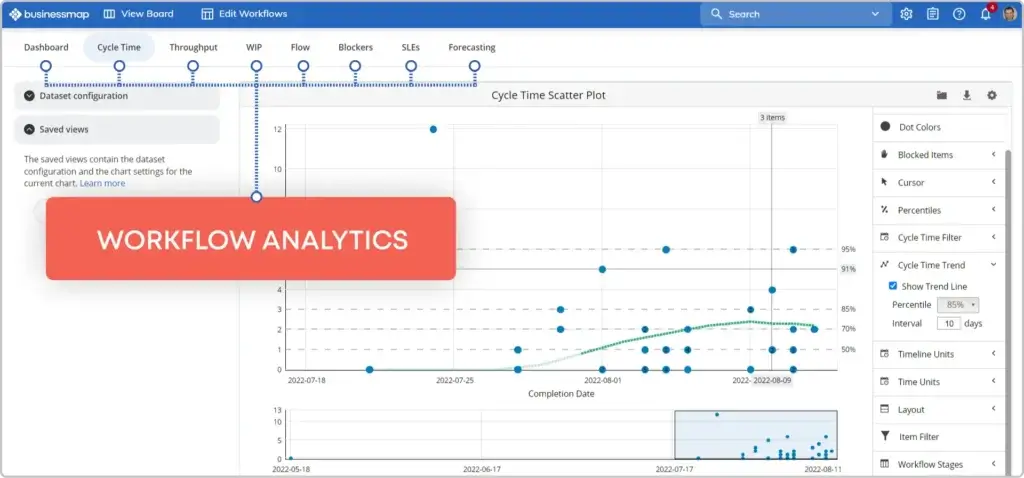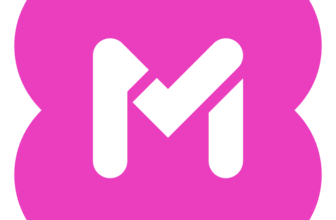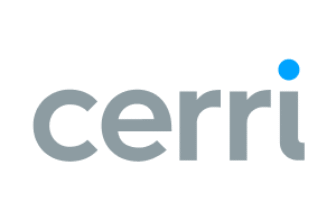Introduction
As work becomes increasingly distributed and complex, project management tools must do more than track tasks. You need a platform that helps your teams visualize workflows, align strategy with execution, and make data‑driven decisions. Businessmap, formerly known as Kanbanize, aims to fill that gap. Built on Kanban principles, this lean project and portfolio management tool has evolved into a comprehensive solution for enterprises seeking end‑to‑end visibility and agility.
In this review, you’ll explore Businessmap’s standout features, pricing structure, strengths and weaknesses, and how it compares to other popular tools. By the end, you’ll know whether Businessmap is the right fit for your organization in 2025.
Businessmap Specification at a Glance
Businessmap is a SaaS platform designed for teams that need to manage projects, portfolios, and strategic objectives. The software combines visual task management with goal alignment and analytics. Here is a quick snapshot:
| Category | Lean project & portfolio management |
| Deployment | Cloud‑based, web & mobile apps |
| Target users | Medium to large teams, enterprises, agile organizations |
| Key highlights | Interactive Kanban boards, portfolio workspaces, OKRs & KPIs tracking, AI tools, customizable workflows |
| Integrations | Slack, Microsoft Teams, GitHub, GitLab, Azure DevOps, Outlook, Zapier, Make |
| Pricing model | Standard plan with per‑user pricing; custom enterprise plan |
Software Specification
Businessmap’s Core Features
Businessmap has grown far beyond its origins as a simple Kanban board. Its robust feature set is designed to help organizations connect long‑term goals with day‑to‑day execution.
Kanban Boards & Workflow Visualization
At the heart of Businessmap are its interactive Kanban boards. You can create unlimited boards and swimlanes to model complex processes. Cards move through columns representing workflow stages, and you can set work‑in‑progress limits to encourage a healthy flow. Multiple workflows can sit on the same board, allowing cross‑functional teams to visualize their work side by side. Timeline and calendar views complement the board view, giving you options for planning and tracking deadlines.
Portfolio Workspaces & Hierarchical Management
Businessmap’s Portfolio Workspaces connect individual boards to higher‑level initiatives. Workspaces support hierarchical management boards where you can link strategic objectives, programs, and projects down to individual tasks. This structure helps leadership see how each initiative contributes to company goals. You can set portfolio priorities, monitor dependencies, and measure progress across multiple teams.
Smart Canvases & Whiteboards
For brainstorming and planning, Smart Canvases provide a flexible space where you can map ideas, build work breakdown structures, and outline dependency chains. Digital whiteboards let your team sketch process maps, mind maps, or product roadmaps in real time. These canvases are linked directly to your Kanban boards, so you can convert sticky notes and sketches into actionable cards with a click.
OKRs, KPIs & Outcome Tracking
Aligning execution with strategy is a central theme of Businessmap. The platform includes native Objectives and Key Results (OKRs) functionality so you can set measurable goals and track progress. You can define OKRs at various levels (company, department, team) and link initiatives and cards to them. Key Performance Indicators (KPIs) dashboards show current metrics, trends and progress toward targets.
AI Tools & Automation
Businessmap has introduced several AI‑powered features to streamline work. An AI Work Assistant can summarize boards, suggest next steps, and help you draft updates. AI analysis tools surface patterns in your flow metrics and identify bottlenecks. Automated business rules let you trigger actions (like moving cards or sending notifications) based on conditions such as due dates, card movements, or custom fields. This reduces manual effort and keeps boards synchronized.
Analytics & Reporting
Data drives improvement, and Businessmap offers a rich set of reports. You’ll find cumulative flow diagrams, cycle time and throughput charts, Monte Carlo simulations for forecasting, and customizable dashboards. Management dashboards provide at‑a‑glance views of portfolio performance, while card‑level analytics help teams optimize processes. For deeper analysis, you can integrate with Power BI to build bespoke reports.
Additional Tools
Beyond its flagship features, Businessmap includes many smaller touches that enhance flexibility:
- Custom fields & card templates – tailor cards to your process and standardize workflows.
- Subtasks & checklists – break large tasks into manageable pieces.
- Swimlanes and WIP limits – organize work by team, priority or class of service.
- Linked boards and mirrored cards – synchronize work across boards, ensuring consistent status.
- Timeline & Gantt views – plan schedules and dependencies at a glance.

Pros and Cons
Advantages and Disadvantages
Positive
✅ Highly flexible visual workflows
✅ Portfolio‑level visibility
✅ Robust analytics and forecasting
✅ Extensive integrations
Negative
❌ Pricing may deter small teams
❌ Learning curve for advanced features
❌ Performance on data‑heavy boards
❌ Limited initiative counts
No tool is perfect, and Businessmap has its share of strengths and limitations. Here’s a balanced look:
Pros
- Highly flexible visual workflows – unlimited boards, swimlanes, and customizable card types let you model almost any process.
- Portfolio‑level visibility – hierarchical boards and OKR linking align strategy with execution across departments.
- Robust analytics and forecasting – built‑in charts, AI analysis, and Monte Carlo simulations provide deep insights.
- Extensive integrations – native connectors and REST API allow integration with Slack, MS Teams, GitHub, Power BI and more.
- Responsive support and active community – many users praise the customer service team and the wealth of training resources.
- Continuous innovation – regular updates introduce new functionality, including AI assistants and improved permissions.
Cons
- Pricing may deter small teams – starting at $149 per month for 15 users, the cost is higher than some entry‑level tools.
- Learning curve for advanced features – the depth of functionality can be overwhelming at first.
- Performance on data‑heavy boards – boards with many cards and heavy automation can experience slower load times.
- Limited initiative counts – some users note that initiative limits in the standard plan restrict large‑scale portfolio planning.
- Custom automation costs extra – unlimited business rules, and SSO requires additional fees or enterprise plans.

User Experience
User Interface and Experience
Ease of Use & Onboarding
Businessmap strikes a balance between flexibility and usability. The drag‑and‑drop interface makes it easy to move cards, adjust columns and reorganize boards. Built‑in templates help you get started, and you can import data from Excel or other tools. The platform’s knowledge base, webinars, and Businessmap Academy courses offer guidance on best practices, so new users can ramp up quickly. That said, some features (e.g., configuring multiple workflows or automation rules) require experimentation and training.
Performance & Scalability
The software is designed to scale from small teams to global enterprises. You can manage thousands of cards across multiple boards and workspaces without hitting hard limits. However, boards with heavy attachments or complex business rules may load more slowly. Businessmap mitigates this by offering dedicated cloud instances and performance tuning in the enterprise plan. For large organizations, the ability to link boards and build hierarchical structures provides scalability that many competitors lack.
Customer Support & Community
Customer service is a standout area for Businessmap. User reviews often mention rapid response times and detailed assistance. Support channels include email, chat, and a ticketing system, and enterprise customers get a dedicated success manager. The community forum and extensive documentation provide self‑service answers. Additionally, the platform regularly hosts webinars and publishes blog articles on agile practices and process improvement.

Integrations and Compatibility
How Businessmap Integrates with Other Software
Native Integrations
Businessmap offers a variety of built‑in connectors to popular tools:
- Slack – bi‑directional integration lets you post updates from Businessmap to Slack channels and create or comment on cards directly from Slack.
- Microsoft Teams – connect boards to Teams channels to receive notifications and collaborate without switching contexts.
- GitHub, GitLab & Azure DevOps – sync pull requests, commits, and issues with Businessmap cards to link development work to project plans.
- Outlook & Gmail – turn emails into cards and keep your inbox and boards in sync.
API & Webhooks
A comprehensive REST API allows you to build custom integrations and automate tasks. Webhooks trigger external actions when cards are created, moved, or updated. Together with business rules, these capabilities support sophisticated automation across your toolset.
Third‑Party Platforms
If you prefer no‑code connectors, Businessmap integrates with Zapier, Make and Power Automate. These platforms open connections to thousands of apps, from CRMs to accounting software. For reporting, a built‑in Power BI connector lets you embed Businessmap data into advanced dashboards.
Platform Availability
Businessmap runs in the cloud and supports modern web browsers. Native mobile apps for iOS and Android provide on‑the‑go access. Single Sign‑On (SSO) via SAML 2.0 and SCIM provisioning ensures secure identity management. Two‑factor authentication (2FA) can be enforced across the account, and administrators can tailor password policies.
Compare with Others
Alternatives to Businessmap
Many teams evaluating Businessmap also consider other work management platforms. The table below highlights how Businessmap compares with monday.com, ClickUp, Wrike, Asana and Jira on key criteria. Short phrases are used to aid scannability.
| Feature Type | Businessmap | monday.com | ClickUp | Wrike | Asana |
| AI Capabilities | AI assistant, summaries, analytics | Limited AI in higher tiers | Basic AI writing & task suggestions | AI writing & risk prediction (Enterprise) | AI for project updates |
| Workflow Visualization | Unlimited Kanban boards & swimlanes | Boards, timelines & calendars | List, board, Gantt, mind maps | Boards & Gantt with dependencies | Boards, timelines & workload |
| Portfolio Management | Hierarchical workspaces & OKRs | Portfolio & goal tracking in Pro/Enterprise | Goals & portfolios available | Customized dashboards & resource views | Goals, portfolios via add‑ons |
| Pricing Model | $149/month for 15 users; volume discounts | Tiered plans; per user pricing starts low | Free tier; paid plans per user | Tiered plans; advanced features extra | Free tier; premium plans per user |
| Support | Responsive; dedicated success manager on Enterprise | 24/7 support on higher plans | Email & chat support; priority support in premium tiers | Standard & premium support tiers | Email & chat support; premium support add‑on |
| Best for | Enterprises needing strategy‑execution alignment | Teams needing flexible work management & colorful UI | Teams seeking an all‑in‑one productivity hub | Organizations prioritizing resource management & customization | Small to mid‑sized teams with straightforward workflows |
This comparison shows that Businessmap excels at connecting strategic objectives to daily work and offers robust analytics and automation. However, competitors may be cheaper for smaller teams or offer broader collaboration features like built‑in documents (ClickUp) or strong UI customizability (monday.com).
Pricing
Businessmap Pricing Overview
Free Trial & Licensing Model
Businessmap provides a 14‑day free trial that unlocks all features, allowing you to test the platform with your team. After the trial, you choose between a Standard plan with per‑user pricing and a custom Enterprise plan. Unlike many competitors, Businessmap avoids feature‑limited tiers; you get core capabilities from day one.
Standard Plan
The Standard plan starts at $149 per month (billed annually) for 15 users. If you prefer monthly billing, the price is $179. Additional user seats are sold in packs of five, and you can scale up to 1,000 users. This plan includes:
- Unlimited Kanban boards, swimlanes and workspaces
- Unlimited card templates, custom fields and subtasks
- Portfolio boards with up to 1,000 user licenses
- OKRs/KPIs tracking and initiative workflows
- Analytics including cumulative flow, cycle time and Monte Carlo simulations
- Integrations and API access
- Standard support and 100GB of file storage
Some add‑ons cost extra in the Standard plan. For example, business rules (automation) are limited to 300 triggers unless you purchase additional packs. Single Sign‑On (SSO) is available as a paid add‑on.
Enterprise Plan
The Enterprise plan is designed for organizations requiring unlimited scalability and enhanced security. Pricing is custom and depends on your number of users and your specific needs. It includes everything in the Standard plan plus:
- Unlimited users and unlimited automation rules
- Dedicated cloud instance with enhanced performance and isolation
- Advanced security – SSO included, IP whitelisting, SCIM provisioning and audit logging
- Priority and 24/7 support, with a dedicated customer success manager
- 1TB file storage and optional data residency
- Consulting and training services to support agile transformations
Additional Costs & Discounts
Businessmap offers volume discounts as you increase the number of users. Annual billing reduces costs compared with monthly billing. You can purchase add‑ons like increased automation limits or dedicated support without moving to the Enterprise plan. Because the platform’s pricing is transparent and not tiered by feature set, you won’t need to upgrade just to access advanced functionalities.
Security and Compliance
Security Measures in Businessmap
Security Controls & Compliance
Businessmap includes a suite of controls to protect your data. Administrators can enforce complex password policies, require two‑factor authentication for all users, and enable Single Sign‑On (SSO) through SAML 2.0. The system supports SCIM provisioning to automate user management. You can also define the lifetime of passwords, require non‑alphanumeric characters, and set minimum lengths.
User Roles & Permissions
Role‑based access control lets you specify who can create, view or edit workspaces, boards and card elements. You can restrict public filters and reports, limit who can attach files or images, and decide which roles manage blockers, tags, and custom fields. Granular permissions help maintain confidentiality while encouraging collaboration.
Data Privacy & Cloud Infrastructure
Data is hosted in secure cloud environments, and enterprise customers can opt for dedicated instances. Administrators can whitelist IP addresses, restrict API and mobile access, and control whether inline images and attachments are allowed. Businessmap adheres to GDPR and other industry regulations, and data is encrypted in transit and at rest. The platform also supports audit logs so you can track every significant action taken in the system.
Audit Logs & Reporting
For compliance and troubleshooting, Businessmap provides detailed audit logs. These records capture changes to user roles, security settings, card movements, and board configurations. Reports can be exported and analyzed to ensure policies are followed and to investigate any suspicious activity.
Businessmap’s Growth Journey
The Company and Product Evolution
Businessmap’s story begins in 2011 when three entrepreneurs, including Dimitar Karaivanov, a lean and Kanban practitioner, set out to make work management more humane and effective. They launched Kanbanize, a tool inspired by the Kanban method that emphasized visualizing work and optimizing flow. Over more than a decade, Kanbanize has evolved from a simple board to a comprehensive platform offering portfolio management, OKRs, and advanced analytics.
In October 2023, the company announced a major rebranding: Kanbanize became Businessmap. The name change reflected its broader vision of providing a “map of the business” that guides organizations toward agility. The rebranding coincided with the acquisition of Berriprocess Agility, led by Teodora Bozheva. This partnership added consulting expertise to the company’s offerings, enabling clients to adopt lean practices with both software and coaching.
Although the brand name changed, the company’s mission remained the same: help people do meaningful work, encourage continuous improvement, and make organizations more innovative. Core values like balance, team excellence, value, and cohesiveness guide product development and customer relationships. Businessmap continues to be privately held and headquartered in Sofia, Bulgaria, serving customers worldwide.
Conclusion
Final thoughts
Businessmap’s story begins in 2011 when three entrepreneurs, including Dimitar Karaivanov, a lean and Kanban practitioner, set out to make work management more humane and effective. They launched Kanbanize, a tool inspired by the Kanban method that emphasized visualizing work and optimizing flow. Over more than a decade, Kanbanize has evolved from a simple board to a comprehensive platform offering portfolio management, OKRs, and advanced analytics.
In October 2023, the company announced a major rebranding: Kanbanize became Businessmap. The name change reflected its broader vision of providing a “map of the business” that guides organizations toward agility. The rebranding coincided with the acquisition of Berriprocess Agility, led by Teodora Bozheva. This partnership added consulting expertise to the company’s offerings, enabling clients to adopt lean practices with both software and coaching.
Although the brand name changed, the company’s mission remained the same: help people do meaningful work, encourage continuous improvement, and make organizations more innovative. Core values like balance, team excellence, value, and cohesiveness guide product development and customer relationships. Businessmap continues to be privately held and headquartered in Sofia, Bulgaria, serving customers worldwide.
Have more questions?
Frequently Asked Questions
1. Does Businessmap offer a free plan?
Businessmap does not have a free plan, but it provides a 14‑day free trial that gives you full access to all features. After the trial, you need to choose a paid plan.
2. How does Businessmap handle resource management?
The platform focuses on workflow visualization rather than traditional resource scheduling. You can use workspaces, swimlanes, and workload views to balance capacity across teams, but it lacks dedicated resource allocation modules found in some PPM tools.
3. Can I use Businessmap for personal task management?
Yes, you can create personal boards and workflows. However, the feature set and pricing are designed for teams. Individuals or very small groups might find simpler tools more cost‑effective.
4. What industries use Businessmap?
Businessmap is industry‑agnostic. It is used by software development teams, manufacturing companies, marketing agencies, government departments and more. Any organization seeking to visualize workflows and align strategy can benefit.
5. Does Businessmap integrate with Jira or Trello?
While there isn’t a native Jira or Trello integration, you can connect Businessmap to these tools via Zapier, Make or custom API scripts. This allows you to sync tasks, comments, or status changes between platforms.
6. How secure is my data in Businessmap?
Businessmap employs strong security measures, including encryption, 2FA, SSO via SAML, SCIM provisioning, and granular access controls. Enterprise customers can opt for dedicated cloud instances and IP whitelisting.
7. Is there on‑premises deployment?
Businessmap is offered as a cloud service only. On‑premises deployment is not currently available, but enterprise customers receive dedicated instances and advanced controls over their environment.
8. How steep is the learning curve?
Basic board setup is intuitive, and many users can start tracking tasks within minutes. Advanced capabilities like portfolio management, automation, and analytics require training and experimentation. Businessmap provides documentation, courses, and support to ease the transition.
9. Can I customize workflows and fields?
Absolutely. You can define custom workflows, add custom fields, create card templates, and set work‑in‑progress limits. This flexibility allows you to mirror your existing processes and adapt as they evolve.
10. Who should consider Businessmap?
Businessmap is best suited for medium‑to‑large teams and enterprises that need to align strategy with execution, manage multiple projects or portfolios and improve their delivery process. If you value end‑to‑end visibility and are ready to invest in a powerful tool, Businessmap is worth exploring.








